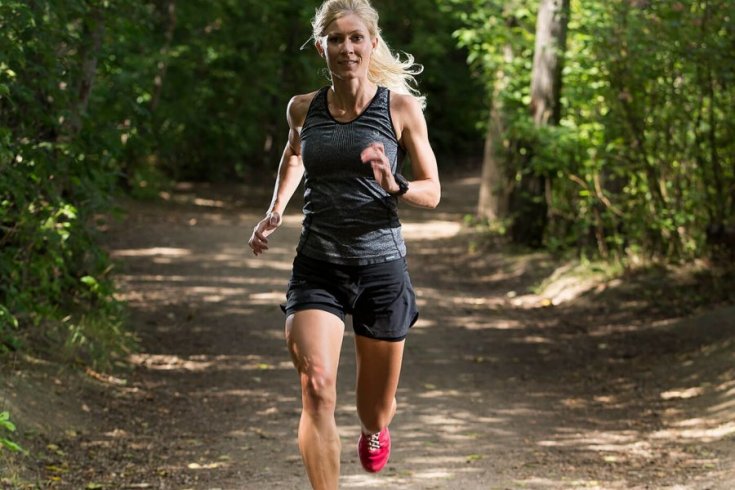When Alissa St Laurent set off towards the eastern slopes of the Rocky Mountains on a bright August morning in 2015, she was confident her intense training would be enough to finish the 125 gruelling kilometres of the Canadian Death Race. Ahead of her were three mountain peaks, leg-numbing switchback climbs, and punishing hairpin descents. In most years, fewer than half of participants finish the race, held annually since 2000, revealing the steely determination needed to overcome pain and exhaustion. But, early in the race, as St Laurent found herself among the sinewy bodies of the lead pack, a male runner looked her over and asked if she thought she could maintain the group’s brisk pace.
Listen to an audio version of this story
Frustration took hold of the then thirty-one-year-old Edmonton accountant. “I just made sure to just stay ahead of him before we got into that first transition area,” she says. St Laurent also remained ahead of every other runner, building an insurmountable lead through determination and patience. After thirteen hours and fifty-one minutes, largely spent racing against herself, she crossed the finish line to become the first woman in the race’s history to win outright. Her closest competitor was nearly an hour-and-a-half behind. She doesn’t know what became of the man who thought she was going too fast too early—only that she left him in her dust.
Longer than the 42.16 kilometres of a marathon, ultramarathons mercilessly have no upper limit; some races can even last days, and sleep isn’t often measured in hours. The masochistic competitions push runners to their physical and emotional limits, as >they traverse desert expanses, vast stretches of highway, or single-track mountain trails. And, with their growing popularity, these long-distance races have led to a reexamination of gender limits in racing: female competitors have begun outrunning their male counterparts with greater frequency—and by large margins.
By the most common perceptions about the biology of strength and endurance, physiology was stacked against St Laurent. On average, her male competitors had bigger hearts, larger lung capacities, and leaner bodies. And most results reflect that: in last year’s marquee Ultra Trail du Mont Blanc TDS, a 145-kilometre mountain race with more than 9,000 metres of elevation gain, the first female to cross the finish line came twenty-third. St Laurent, who placed fifth among women, came sixty-first overall.
But, on that August day in the Rockies, St Laurent obliterated the competition. And she isn’t alone: in 2002 and 2003, American runner Pam Reed shocked the ultrarunning community with back-to-back wins at the Badwater 135—a 217-kilometre course through California’s Death Valley that destroys even the hardiest competitors. Vancouver-based Ellie Greenwood, who has four outright ultramarathon wins to her name, began snagging the top spot in races as early as 2010. And, in 2017, two years after St Laurent won the Death Race, Ailsa MacDonald won the Sinister 7— a 161-kilometre trail race—by a similar hour-and-a-half margin. That year proved to be a watershed moment for outright victories for women: Camille Herron ran the fastest 160 kilometres on any trail in the world that year in twelve hours and forty-two minutes—after she knocked back some beer in the final leg of the Tunnel Hill 100 Mile trail race. In the debut of the Moab 240 Endurance Run, a race of nearly 400 kilometres in Utah’s scorching desert, then biology teacher Courtney Dauwalter cruised to victory ten hours ahead of her closest competitor. And, this January, Jasmin Paris won the Montane Spine, a 431-kilometre slog along the rugged backbone of the United Kingdom’s Pennine Way. The British runner crushed the previous course record by twelve hours—all while pumping breast milk at the aid stations for her fourteen-month-old child. This cascade of recent victories has raised a critical question—are these women outliers or are they a searing rebuttal to the idea that men, at all distances, are faster?
The easy explanation for how St Laurent and others pulled off their feats: they rarely miss a day of training. “She’s just very focused when she puts her mind to getting a task done,” says Ryne Melcher, St Laurent’s former coach. “It’s really only Alissa that can get in the way of Alissa.” While her love for the mountains and nature explains her ability to grind out early morning workouts, new research suggests there might be more at play on race day.
After scouring the results of nearly 100,000 marathon finishers, Sandra Hunter, a professor of exercise science at Wisconsin’s Marquette University, made an interesting—if not intuitive—find. The more men there are in a race relative to the amount of women, the bigger the performance gap between those genders. “If you had one female for every twenty men, the likelihood that that female is going to be the best . . . compared with the best male in that age group is pretty small,” says Hunter.
For generations, women were burdened with artificially low expectations, and for years, they were barred from competing in long-distance races. On a chilly April morning in 1967, Kathrine Switzer’s attempt at the Boston Marathon was memorialized in a grainy front-page newspaper photo: the race organizer lunging at twenty-year-old Switzer, his arm outstretched to rip off her race number. She eventually finished the race. When the Amateur Athletic Union, the governing body that sets guidelines for running races in the US, finally changed its rules in 1971 (it wasn’t until 1984 that women were allowed to run the marathon in the Olympics), allowing women to compete in road races in the United States, it was as if a dam had burst. The women’s marathon world record dropped so dramatically that academic papers in the 1990s predicted women—as a group—would eventually overtake men. In fact, the times were more akin to what would have already been achieved had women not been denied the chance to compete in the first place.
With significantly more women now running in competitions than there were in previous decades, the performance gap between women and men—at least in marathons—has narrowed. “If you were comparing the best man to the best woman in a marathon, and they had the same training and they were the best in their field, the best genetically in the whole group, you’d expect about a 10 to 12 percent difference—that men will always outperform women,” says Hunter. (The current men’s world record in a marathon is two hours, one minute, and thirty-nine seconds; the women’s is two hours, fifteen minutes, and twenty-five seconds.) But the longer the race, the more these assumptions begin to crumble.
Drop the average runner onto a mountain trail, and after the minor creaks and groans fade away, their legs will churn with enough rhythm to produce the illusion of near-effortless movement. Eventually, though, strides that felt easy begin to require a focused effort. Inclines that were once taken with bounce now feel steeper. Breathing becomes heavier. And even the most well-prepared racers can end up bent over, vomiting a neon slurry of sports gels and rehydration drinks. “You show up at the start line in the best shape of your life, and by the time you get to the finish line, you’re in the worst shape of your life,” says Melcher, recounting a time-worn adage of long-distance running.
Studies are starting to show that male and female bodies respond differently to fatigue: during long periods of exercise, the brain monitors and triages the body’s output, regulating feelings of exhaustion to ensure the runner doesn’t overextend themselves. If the central nervous system senses the activity is becoming too intense, it reduces the muscle’s output. “What we are seeing is that, in ultramarathons, more and more of the fatigue comes from central fatigue, which means that the brain is not able to drive the muscle, even though the muscle is capable,” says Shawn Bearden, a professor of exercise physiology at Idaho State University. Researchers in France have hooked runners up to electrodes to stimulate muscles, demonstrating they still have the ability to produce movement. “There’s something about a person’s brain that just isn’t driving the muscle as well late in these very long-distance races,” Bearden says. “It turns out women have a slightly, it seems, better resistance to that kind of fatigue.” While some studies show no real difference—women are on par with men—others show women with an ever-so-slight advantage. “Running economy and fatigue resistance are places where women seem to have a bit of an edge,” says Bearden. “And, with those two factors, the longer the distance of the race, the more important those two factors are.”
While competing at the Tunnel Hill 50 in Illinois, a runner sidled up to Neela D’Souza, a power-plant shift manager from Pickering, Ontario. “You might be going a little too quick,” he warned her, adding that he was a running coach. D’Souza, who now has three outright ultramarathon wins, politely rejected his suggestion and continued at her pace—pulling far ahead and becoming the first woman, and third runner overall, to finish.
For researchers, this interaction—similar to the one St Laurent experienced during the Death Race—holds valuable clues. “Typically, you see the men start off fairly fast and slow down. You see the women start off with a relatively even pace and keep going at that pace and perhaps accelerate,” says Richard Hughson, a physiologist and a former elite marathon runner. The University of Waterloo professor has observed the pacing of male and female runners and has noticed that, on average, men pace themselves poorly in a race, exploding from the start line, then slowing down throughout the course. There are a handful of theories of why this might be the case, including Hughson’s suspicion that male competitors are socialized to run more aggressively at the start of a race, in spite of common training ideology that suggests it’s better to be a tortoise than a hare.
A marathon is run on a relatively flat, paved road designed to remove variables. But because there are so many hazards along the course of an ultramarathon—from tree roots and loose rocks to bee stings and hallucinations—few runners have perfected their craft. No one factor in an ultramarathon will propel a winner to the podium, but a single mistake can remove any runner from the race. An ultramarathon, therefore, may be the competition where gender matters the least.
After Alissa St Laurent crossed the Canadian Death Race’s finish line, the victory didn’t strike her as noteworthy. The media coverage that followed unnerved her: while she answered questions for reporters, the attention felt at odds with her running philosophy—that competing is simply about getting the best out of herself. Instead, she dwelled on a momentary loss of focus at one part of the race, which she believes cost her the women’s course record. That section—Old Mine Road—is the lowest part of the race, is punctuated by water crossing slippery rocks, and is the one she keeps returning to in her mind, confident she could do better if given a chance to redo. But, by leg four, a deliriously steep ascent, her competitive edge returned. “I think I climbed Mount Hamel—the highest point of the race—faster than . . . maybe anyone.”
For runners like St Laurent, who spend hours upon hours communing with the trails, running is a rebellion against the nagging thoughts of failure that echo in the back of the mind, and pain and fatigue are shed with every step forward. And, on the best days, it’s about racing harder and faster than anyone thought possible.





